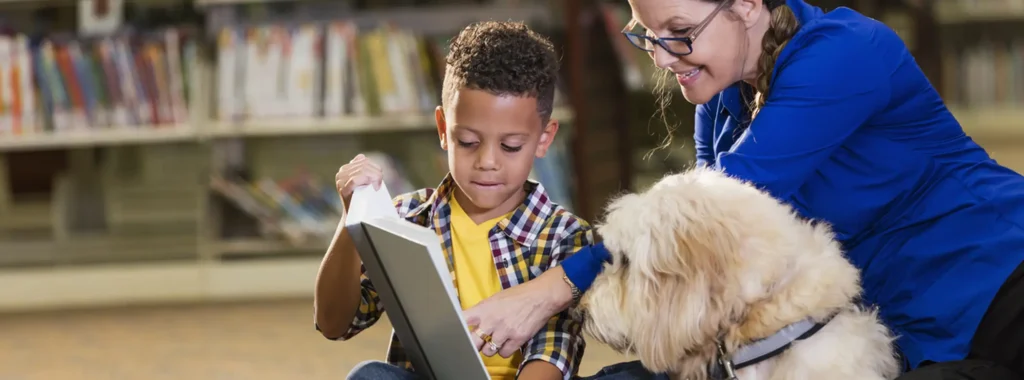In recent years, therapy dogs have become an integral part of educational settings, providing emotional support and fostering a positive environment for students. These specially trained canines play a significant role in alleviating stress, promoting social interaction, and enhancing the overall well-being of students. But what exactly do therapy dogs in schools do, and how can your dog become one? Let’s explore the multifaceted roles these furry companions play in educational institutions.
The Role of Therapy Dogs in Schools
Emotional Support and Stress Relief
Therapy dogs are renowned for their ability to provide emotional comfort. In schools, they serve as non-judgmental listeners and companions for students experiencing anxiety, stress, or emotional challenges. The mere presence of a friendly dog can significantly reduce cortisol levels (the stress hormone) in students, promoting a calm and focused learning environment. This emotional support can be particularly beneficial during exam periods or stressful personal times.
Enhancing Social Interaction
These dogs encourage students to engage more with their peers and teachers. As a common point of interest, therapy dogs facilitate conversations and connections among students, helping shy or introverted children open up and participate in group activities. In special education settings, therapy dogs can also help children with autism or other developmental challenges develop social skills and improve communication.
Creating a Positive Environment
A therapy dog’s presence in a classroom can transform the atmosphere, making it more welcoming and inclusive. Students are more likely to express themselves freely and engage in learning activities when they feel comfortable and supported. This nurturing environment not only enhances academic performance but also contributes to better mental health outcomes.
The History and Evolution of School Therapy Dog Programs
The concept of animal-assisted therapy dates back to the 1960s, with pioneers like Boris Levinson and Konrad Lorenz recognizing the therapeutic benefits of human-animal interactions. By the 1990s, schools began integrating therapy dogs into educational programs, acknowledging their potential to support student well-being and academic achievement.
Over the years, these programs have evolved, with many schools across the nation incorporating therapy dogs into their mental health and wellness initiatives. Today, therapy dogs are a common feature in schools, helping to create a supportive and engaging learning environment for students of all ages.
Who Supplies Therapy Dogs to Schools?
Organizations and trained professionals typically supply therapy dogs to schools. These organizations specialize in training dogs to work in various therapeutic settings, ensuring they possess the right temperament and skills to interact with students. Some well-known organizations include:
- Alaska Dog Works: offers comprehensive training and certification for therapy dogs, particularly for professional offices (such as psychologists and therapists), churches, and schools throughout North America.
- Pet Partners: Offers comprehensive training and certification for therapy animals, including dogs, to work in schools and other settings.
- Alliance of Therapy Dogs: Provides registration, support, and insurance for therapy dog teams, facilitating their placement in schools.
- Therapy Dogs International: Focuses on testing and registering therapy dogs and their handlers for volunteer visits, including school programs.
These organizations ensure that therapy dogs are well-prepared to meet the diverse needs of students and make a positive contribution to the school community.
Can Your Dog Become a School Therapy Dog?
If you’re wondering whether your dog has what it takes to become a school therapy dog, the answer is—maybe! Several factors determine a dog’s suitability for this role:
Temperament and Behavior
Therapy dogs must be calm, friendly, and adaptable to different environments. They should enjoy interacting with people and be able to remain composed in crowded or noisy settings. Dogs that are easily frightened or aggressive are typically not suitable for therapy work.
Training and Certification
To become a certified therapy dog, your pet must undergo specialized training. This training focuses on obedience, socialization, and exposure to various stimuli they might encounter in a school environment. Many organizations offer training programs to help prepare dogs for therapy work.
Health and Well-being
Therapy dogs should be in good health and up-to-date on vaccinations. Regular vet check-ups are essential to ensure they are fit to work in school settings and interact safely with students.
The Impact of Therapy Dogs on Students
Academic Improvement
Research suggests that the presence of therapy dogs in schools can lead to improved academic performance. Students are more engaged and motivated to learn when they feel supported emotionally. Therapy dogs can also help improve attendance rates, as students look forward to interacting with these friendly companions.
Emotional and Psychological Benefits
Therapy dogs offer emotional support to students facing personal challenges or mental health issues. Their non-judgmental nature makes them ideal companions for students needing someone to confide in or relax with during stressful times.
Promoting Empathy and Compassion
Interacting with therapy dogs teaches students valuable lessons in empathy, compassion, and responsibility. Caring for and spending time with these animals encourages students to develop a sense of empathy and understanding towards others, fostering a more inclusive and supportive school culture.
Implementing a Therapy Dog Program in Schools
Steps to Get Started
Assess the Need: Evaluate the specific needs of your school community and how a therapy dog could address them. Consider conducting surveys or meetings with staff and students to gather input.
Partner with Organizations: Connect with reputable therapy dog organizations to explore partnership opportunities. These organizations can provide guidance, training, and support throughout the implementation process.
Develop Policies and Guidelines: Establish clear policies and guidelines to ensure the safety and well-being of both students and therapy dogs. This includes protocols for health and hygiene, as well as procedures for interactions between students and dogs.
Train Staff and Volunteers: Ensure that staff and volunteers involved in the program receive adequate training to work with therapy dogs and understand the program’s objectives.
Evaluate and Adjust: Regularly assess the program’s impact on students and make necessary adjustments to enhance its effectiveness. Gather feedback from students, staff, and parents to continually improve the program.
Conclusion
Therapy dogs play a crucial role in fostering a supportive and engaging learning environment in schools. Their ability to provide emotional support, promote social interaction, and create a positive atmosphere makes them invaluable assets to educational institutions. Whether you’re considering introducing a therapy dog program in your school or exploring the possibility of your dog becoming a therapy companion, the benefits are clear. These remarkable animals have the power to transform the educational experience, promoting well-being and academic success for students nationwide.










